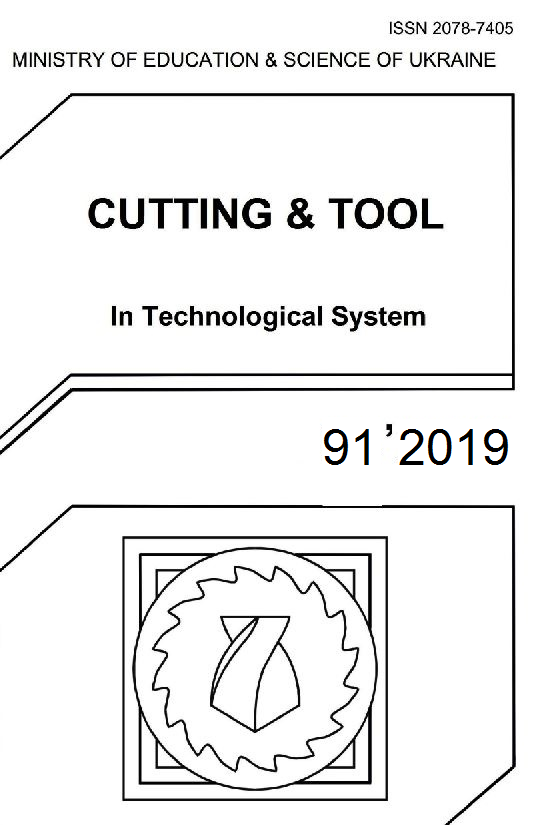FEM INVESTIGATION OF CUTTING FORCE COMPONENTS IN HIGH-FEED FACE MILLING
DOI:
https://doi.org/10.20998/2078-7405.2019.91.18Keywords:
Finite Element Analysis, High feed milling, Cutting force components.Abstract
Face milling is widely used cutting method for creating planar surfaces. The efficiency of the machining process can be increased by removing the same undeformed chip cross section with higher feed rates and less allowance. The article shows the effects of this changing ap/fz ratio on the different cutting force components acting both on the workpiece and on the tool. The force values were determined by FEM simulation, and then the results were validated by data obtained by cutting experiments.References
Kundrák J, Markopoulos AP, Makkai T, Nagy A: Theoretical and Experimental Analysis of the Effect of Chip Size Ratio on Cutting Forces in Face Milling of Steel. International Journal of Mechanical Engineering 2018 3(1): 29-35.
Karpuschewski, B., Kundrák, J., Emmer, T., Borysenko, D.: A new strategy in face milling - inverse cutting technology. Solid State Phenomena 2017 261: 331-338 https://doi.org/10.4028/www.scientific.net/SSP.261.331.
Kim HS, Ehmann KF: A cutting force model for face milling operations. International Journal of Machine Tools and Manufacture 1993 33(5): 651-673 https://doi.org/10.1016/0890-6955(93)90099-G.
X.P. Li, A.Y.C. Nee, Y.S. Wong, H.Q. Zheng: Theoretical modelling and simulation of milling forces. Journal of Materials Processing Technology 1999 89-90:266-272 https://doi.org/10.1016/S0924-0136(99)00076-X.
Palanisamy, P., Rajendran, I., Shanmugasundaram, S., Saravanan, R. (2006). Prediction of cutting force and temperature rise in the end-milling operation. Proceedings of the Institution of Mechanical Engineers, Part B: Journal of Engineering Manufacture, 220(10), 1577–1587.
Gyliene V., Eidukynas V.: The Numerical Analysis of Cutting Forces in High Feed Face Milling Assuming the Milling Tool Geometry. Procedia CIRP 2016 46:436 – 439 https://doi.org/10.1016/j.procir.2016.03.132.
Beňo J, Maňková I., Vrábel M., Karpuschewski B., Emmer T., Schmidt K.: Operation Safety and Performance of Milling Cutters with Shank Style Holders of Tool Inserts. Procedia Engineering 2012 48:15-23 https://doi.org/10.1016/j.proeng.2012.09.479.
Trung, N. D., Potenzial eines Rundschaft–Fraeswerkzeugsystems fuer Forschung und Produktion. Dr.-Ing. Dissertation, Otto-von-Guericke University Magdeburg, Shaker Verlag Aachen, 2009.
Varga, G., Kundrák, J.: Effects of technological parameters on surface characteristics in face milling, Solid State Phenomena 2017 261:285-292. https://doi.org/10.4028/www.scientific.net/SSP.261.285.
Kundrák, J., Markopoulos, A.P., Makkai, T., Deszpoth, I., Nagy, A.: Analysis of the effect of feed on chip size ratio and cutting forces in face milling for various cutting speeds. Manufacturing Technology 2018 18(3):431-438 https://doi.org/10.21062/ujep/117.2018/a/1213-2489/MT/18/3/431.
Downloads
Published
Issue
Section
License
Copyright Notice
Authors who publish with this Collection agree to the following terms:
1. Authors retain copyright and grant the Collection right of first publication with the work simultaneously licensed under a Creative Commons Attribution License that allows others to share the work with an acknowledgement of the work's authorship and initial publication in this Collection.
2. Authors are able to enter into separate, additional contractual arrangements for the non-exclusive distribution of the Collection's published version of the work (e.g., post it to an institutional repository or publish it in a book), with an acknowledgement of its initial publication in this Collection.
3. Authors are permitted and encouraged to post their work online (e.g., in institutional repositories or on their website) prior to and during the submission process, as it can lead to productive exchanges, as well as earlier and greater citation of published work.

